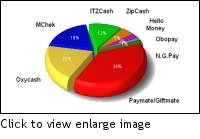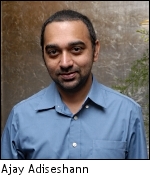Manoj Kohli, chief executive officer and joint managing director, Bharti Airtel, said that mobile phone tariffs will fall further only if there is a cut in the high taxes and levies (of about 13 per cent) prevailing in the Indian telecom sector. He said this on the sidelines of the India Telecom 2009 that took place in New Delhi on Thursday.
He added that if the tax cut does not happen then there is no scope for more reduction in tariffs as they have already touched a rock bottom with a rate of almost one cent per second currently.
On the roll out of 3G services by the telco, Kohli said that by Diwali of 2010 Airtel subscribers will be able to use the next generation network if the auction happens as per schedule.
Further tariff cuts only with fall in taxes, says Kohli, Airtel
Mobile commerce set to take off in India
 With a mobile phone subscriber base of 500 million, which is expected to reach 700 million by 2012 according to the Department of Telecommunications ( DoT), the country can easily expect mobile commerce or m-commerce to take off faster than online or e-commerce.
With a mobile phone subscriber base of 500 million, which is expected to reach 700 million by 2012 according to the Department of Telecommunications ( DoT), the country can easily expect mobile commerce or m-commerce to take off faster than online or e-commerce.
The mobile payment scenario in India usually works like this – an operator, a payment service provider and a bank get together to facilitate the service using SMS or internet-enabled mobile phones. The users need to register with the m-commerce service providers to do mobile transactions. This payment system enables users to purchase air, rail and movie tickets, do retail transactions and money transfers as well as pay utility bills.
Banking on mobile
Banks have realised the importance of this medium and are now open to tie ups with operators and service providers to offer mobile banking services. Moreover, lack of proper banking infrastructure combined with low penetration of computers and Broadband is expected to give a fillip to payments via mobile.
ICICI Bank Ltd, India’s largest private sector bank, is offering all its services via mobile banking since January 2008. Almost all banks today, whether private or state-owned, offer some form of mobile banking to customers. While not all enable actual money transfer to take place on mobile, most offer SMS alerts and updates to their customers.
A recently released study by The Nielsen Company and Paymate taking a base of 434 m-commerce users shows that most respondents registered with their respective m-commerce service provider within the last one year. Customers also gained confidence after the Reserve Bank of India issued guidelines on mobile payments in October 2008.
Early movers
Mumbai-based PayMate was the first to launch a mobile payment service in India. PayMate allows users to register using an existing bank account, credit card or a prepaid voucher to make secure payments. After registration on Paymate, every user is provided with a PIN code, which is used to verify the transactions done by the user.
 According to Ajay Adiseshann, founder and managing director, PayMate, mobile banking in India has seen a 94 per cent growth since 2002 and currently there are about 5 million m-commerce users in the country. He also says that the industry estimates put the number of users at 25 million by 2012, and 100 million in the next five years.
According to Ajay Adiseshann, founder and managing director, PayMate, mobile banking in India has seen a 94 per cent growth since 2002 and currently there are about 5 million m-commerce users in the country. He also says that the industry estimates put the number of users at 25 million by 2012, and 100 million in the next five years.
Adiseshann adds, “Considering the vast popularity of mobile phones and the fact that services are no more restricted to only the banking population, the industry will surpass all expectations in the years to come.” At present PayMate has about one million users across India.
PayMate charges merchants a transaction fee on the total value of the transaction. Also, a fixed fee is charged in certain cases where leads are acquired through the mobile interface. Essentially, revenues are supported by charging a percentage commission on every transaction that is processed through the mobile payment gateway.
As per USA-based analyst firm Research And Markets, the Indian microfinance sector is expected to grow to nearly ten times by 2011 to a size of about Rs 25,000 crore from the current market size of Rs 2700 crore, at a compounded annual growth rate of 76 per cent. Microfinancing means the provision of financial services to low income consumers, who do not have access to banking credit.
Another m-commerce service provider, USA-based Obopay, foresees mobile banking and payments being used as a catalyst to spread microfinance and financial inclusion in India.
 Deepak Chandnani, president, Asia and Africa, Obopay, says, “In India, mobile penetration is increasing at a very high rate whereas banking is not increasing at the same rate. More than 40% of Indians are unbanked and many are under-banked. We thought India is the perfect market for mobile payments where we can marry banking and rapid proliferation of mobile phones.”
Deepak Chandnani, president, Asia and Africa, Obopay, says, “In India, mobile penetration is increasing at a very high rate whereas banking is not increasing at the same rate. More than 40% of Indians are unbanked and many are under-banked. We thought India is the perfect market for mobile payments where we can marry banking and rapid proliferation of mobile phones.”
The company has recently partnered with Yes Bank in India and has also tied up with Nokia globally to launch Nokia Money. Chandani adds, “We are currently in talks with various telecom companies and banks. Currently all large banks in India are offering mobile banking services. Information and alert based services are the most popular services currently. It is expected that this will graduate to mobile money transfer and mobile payments in the coming years.”
Some other key players in the m-commerce sector include mChek, Atom Technologies, NGPay, Eko and Jigrahak.
Services on the go
Several companies in the service sector are also taking to this medium pretty aggressively. PVR Cinemas, one of India’s largest cinema chains, had launched a mobile ticketing application early this year, which can be downloaded by any user with a internet-enabled handset. This application is available to all mobile phone users irrespective of the operator. A movie ticket booking website, Bookmyshow.com, also offers a mobile application to users wishing to buy movie tickets via mobile.
Similarly, Makemytrip.com, a travel portal, also has a sound m-commerce product. The portal offers instant search, bookings, payments and ticket delivery through a mobile application anywhere and anytime without any extra charges.
 Sachin Bhatia, co founder, Makemytrip, tells Telecom Yatra, “We entered the mobile commerce space about two and half years ago as we firmly believe that the mobile penetration, reach and convenience cannot be matched by any other channel. M-commerce breaks distance barriers and enables us to reach rural consumers easily and provide quality services. The belief that security and risk control factors of transactions is high has also made users trust mobile based transactions.”
Sachin Bhatia, co founder, Makemytrip, tells Telecom Yatra, “We entered the mobile commerce space about two and half years ago as we firmly believe that the mobile penetration, reach and convenience cannot be matched by any other channel. M-commerce breaks distance barriers and enables us to reach rural consumers easily and provide quality services. The belief that security and risk control factors of transactions is high has also made users trust mobile based transactions.”
The portal has partnered with telecom service providers such as Airtel, Aircel, Vodafone and Tata Teleservices to offer the mobile application to its users. It is offering m-commerce services in partnership with NGPay, Atom, mChek, mobisoc and Paymate along with an ‘open to all’ service, which can be accessed from any network by the user.
Bhatia adds, “We now get a daily average of 15,000 user hits and 200 domestic flight bookings through our m-commerce services and expect a heavy increase in trials and transactions with our bus, cab and train ticketing going live on our applications soon.”
IRCTC (Indian Railway Catering and Tourism Corporation), which sells railway tickets online, also has a mobile application that works on mobile internet. It was launched in April 2007 and allows users to book tickets, check their PNR status and see train schedules.
Internationally, giants such as Amazon, Mastercard and Alcatel Lucent, have also launched mobile payments service recently. As the utility of the mobile phone increases with its subscriber base, financial transactions on mobile will certainly become very significant for users.
Tata’s new service to stream live TV on broadband
Tata Teleservices Limited (TTSL), the telecom operator which owns the brands Tata Indicom and Tata Docomo, has launched a live TV streaming application for computers. The application, Photon TV, will allow Tata Photon Plus postpaid subscribers to watch live television channels on their PCs and laptops.
Tata Photon Plus is the wireless Broadband service of the company launched in 2008 in Tamil Nadu, and now available in 70 cities across 22 states in the country. It offers live video streaming, webcasts and online games. TTSL launched its first mobile Internet device, Plug 2 Surf, in 2007.
Subscribers to the new application can view live TV feed from various sports, news, entertainment and regional channels. They can also watch recorded TV shows, movies, music and videos on demand. Some of the channels available for streaming presently are ESPN, NDTV 24×7, CNBC TV18, CNN, Zoom, Pogo and Jaya TV. It is currently available with three subscription options – Rs 4 per channel per month, Rs 29 per month for My Combo (10 channels) and Rs 75 per month for all channels. Data charges will be applicable as per the subscriber’s data plan.
Talking to reporters at a press conference, Anil Sardana, managing director, TTSL, said, “We are not providing channels that have not passed the regulatory hurdle, for example Doordarshan. We will be running the service on 4.4 Mhz spectrum and will upgrade when 3G arrives,” he added.
TTSL has worked jointly with Apalya Technologies to launch the Photon TV application. Aplaya develops platforms for streaming video content to consumers by integrating mobile operators, content owners and mobile advertisers.
MTNL buckles, launches pay-per-second plan
Mahanagar Telephone Nigam Limited (MTNL) has finally joined the tariff war by launching its pay per second plan, almost a month after its counterpart Bharat Sanchar Nigam Limited (BSNL) announced a similar plan.
Interestingly, Gurudas Kamat, Minister of State for Communications and Information Technology had said this in the Lok Sabha on November 23: “MTNL has neither implemented nor has any plan at present to implement tariff based on per second billing system. As per Telecom Tariff Order issued (and amended from time to time) by TRAI, mobile operators have the flexibility to offer variety of tariff plans depending on the market conditions and subject to reporting of the same to TRAI.”
When asked about the change of plan, Shashank Malviya, deputy general manager, PR and marketing, told Telecom Yatra, “There is no other way. Market forces have compelled us to go for pay per second. Every customer is demanding this and we have to give them what they want.”
Under the new plan, both prepaid and postpaid subscribers will be able to make voice and video calls at half a paise per second to MTNL Delhi and Mumbai networks. They would be charged at one paise per second for calls made to any other network across India.
The SMS rates have also changed. The subscribers will now be charged at 25 paise for local, one rupee for national and Rs 2.50 for international SMS. The company has also introduced very low data usage charges on mobile – one paisa per 10KB, applicable to both GPRS and 3G Jadoo services.
The company says in a statement that MTNL currently has 4.4 million subscribers on its mobile services, including about 140,000 3G customers.
MTNL Delhi customers seeking a new prepaid (Trump) connection can avail this lifetime validity tariff plan by purchasing a SIM kit worth Rs 100 and a Trump activation coupon of Rs 49. An existing MTNL prepaid customer willing to shift to pay per second plan needs to recharge his connection with a prepaid voucher of Rs 45. The tariff validity will be 365 days for such conversion.
Existing MTNL postpaid (Dolphin) subscribers too can avail the new plan by giving a fixed monthly charge of Rs 149 and new subscribers need to pay a one time activation charge of Rs 500 plus taxes.
GSM mobile services are being provided by MTNL in Mumbai, Delhi and the towns of Ghaziabad, Noida, Gurgaon, Faridabad and Navi Mumbai.
Nokia launches advanced messaging app with E72
Handset giant Nokia has announced the arrival of its E72 handset model in India, a week after it was launched internationally. The Nokia E72 is bundled with the latest version of Nokia Messaging, an email service for mobile phones that enables users to manage multiple mailboxes with one simple interface.
The email application provides access to work emails when based on Microsoft Exchange, and personal emails, such as Gmail, Yahoo Mail, Hotmail, Ovi Mail and many more. It also supports instant Messaging on all popular chat platforms such as Gtalk, Yahoo and Ovi Chat. The application provides for sorting and searching emails as well as accessing Microsoft Office documents. It allows emails to be delivered to the device automatically without having to check for new emails constantly.
According to a Nokia statement, Nokia Messaging has more than one million users worldwide and it is present in more than 50 countries. The application is supported by more than 30 Nokia devices available in the world market.
Through Nokia Messaging, a person can set up an email account directly. To enable this application, a user needs to select ‘Set up Email’ option on the home page and then enter email address and Password to log into the account. Nokia messaging aggregates all consumer and business email accounts through one client that can support multiple accounts. The user can have up to 10 personal email accounts and one business account for both Mail for Exchange and IBM Lotus Traveler.
Vineet Taneja,marketing director, Nokia India, said on the sidelines of a press conference, “Corporates are the first who are going to adopt this, next is SMEs (small and medium enterprises) and professionals. People looking for a great phone as well as a great email solution are those who will adopt this phone.”
On promotional plans for E72, Taneja told Telecom Yatra, “There are three legs to our plans. Firstly, a very big digital plan. Secondly, we have a large database of people using E71, so they are going to be a target group. Lastly we will push it with the corporates.”
The Nokia E72, priced at Rs 22,989, will be available in the Indian market starting today.
SMS rates set for freefall, now at one paisa
Post the tariff war on voice services, it is the SMS rates that are now being slashed. In the extended telecom war, Anil Ambani-owned Reliance Communications has initiated the battle of SMS rates.
The company has introduced one paisa per SMS scheme for its pre-paid as well as post-paid subscribers on GSM and CDMA. All Reliance Mobile customers, regardless of the tariff plans they have for voice and data services, can avail of the one paisa per SMS plan by subscribing to a standard tariff voucher of Rs 11 per month.
Mumbai-based Reliance Communications has a combined GSM and CDMA subscriber base of 90 million under the brand name Reliance Mobile.
Most mobile operators, including Bharti Airtel and Vodafone, generally offer SMS at one rupee for local and Rs 1.50 for national SMS.
Commenting on the tumbling SMS rates, Mahesh Uppal, telecom analyst and director, Con First India, says, “It was very much expected that after voice it will be the falling SMS rates since it costs very less for the operators.”
Uppal further says that voice has certain capacity to hold calls. He feels the small players will be at a loss as they may be on the receiving end. The cash flow of these operators might get affected as they do not have the ability to raise investments.
Value added services, including SMS, accounts of about 10 per cent of the total telecom revenues of which SMS has a major share. Other players too are likely to follow suit soon. The voice calls in India have fallen to 1 paisa per second, touted to be the lowest in the world.
3G will be a game changer, say PE investors in survey
A survey done by Venture Intelligence, a research firm focused on private equity, and merger and acquisition deals activity, shows that almost 70 per cent of the private equity (PE) and venture capital (VC) investors surveyed felt that Indian telecom operators would be able to profitably serve the next 100 million mobile consumers from rural areas.
A majority of investors are also believe that the introduction of 3G (third generation network, a technology which will allow rich media services to be offered on mobiles) services can be a game changer for various players in Indian telecom. The survey respondents comprised of fund managers from over 50 PE and VC firms who have invested $5 billion in telecom and related companies over the past five years.
Speaking to Telecom Yatra, Arun Natrajan, chief executive officer, Venture Intelligence, points out that the PE and VC investors will be now keen in investing in telecom companies providing 3G services. He added the increasing investment on upgrading towers and software for rolling out 3G will make operators look for further investments.
Natrajan further stated that in recent months, intense and rising competition levels, declining ARPUs (average revenue per user), high costs of 3G licenses and the impending introduction of Mobile Number Portability (MNP, which will allow subscribers to change their mobile operators while keeping their number), have placed significant challenges before the industry.
52 per cent of the respondents said that 3G services will be a game changer. Not surprisingly, 54 per cent said that the existing 2G companies would not be able to gain further market share.
3G is especially good news for investors as it presents an opportunity to enhance revenues for value added services (VAS, including new types of services such as gaming) and other data services quite significantly. For operators, 3G will help increase ARPUs especially in the metros and large towns. 3G services can also enable mobile users who do not have prior exposure to computers to access Internet-based services.
Thus, investors are particularly interested in investing in VAS companies, telecom software developers and other companies that provide services to operators.
On the other hand, investors who disagree that 3G will be a game changer cite the high costs and lack of compelling applications as the main reasons that will slow down adoption of 3G based services. Chennai-based Venture Intelligence was launched in 2002 and provides information and analysis on private equity, venture capital and M&As in India.
MTNL offers voice and video calls at 20 paise per minute
Mahanagar Telephone Nigam Limited (MTNL) has announced a cut in its voice and Video call tariffs for Trump prepaid subscribers. The services will now be available at 20 paisa per minute on the recharge coupon worth Rs 108.
In addition to providing voice and video calls to MTNL’s Mumbai and Delhi networks at 20 paise per minute, the coupon also offers local calls to other networks and calls to Maharashtra and Goa networks at 50 paise per minute and STD calls at 75 paise per minute. The coupon comes with a validity of 180 days.
The announcement comes a fortnight after Bharat Sanchar Nigam Limited (BSNL) launched a promotional 3G tariff plan for its prepaid customers.
Under this the consumers are being charged at a rate of 30 paisa per minute for voice calls, both local and STD, as well as video calls.
Airtel extends one paisa per second to NRIs in USA
Airtel CallHome, a calling card service for NRIs, has launched a pay per second plan for USA subscribers making calls to India.
The $6.99 (Rs 350) plan comes with an administration fee of $0.49 (Rs 25), offering customers a tariff of 0.03 cents (one paisa) per second on the balance $6.50 (Rs 300). The plan has a validity of 30 days.
Airtel had earlier launched offers such as ‘India One’- a one cent calling plan to circles across India, and ‘Mharo Plan’- for calling to Gujarat, Mumbai, Maharashtra and Rajasthan, meant for Indian expatriates staying in the USA. It enables NRIs to make calls to India even if the phone doesn’t have international calling facility.
Airtel CallHome is available in the USA, the UK, Canada and Singapore. A user can sign up for Airtel CallHome online and can select a calling plan by registering up to three phone numbers, an email address and other personal information. The payment can be done online. After signing up, a subscriber can use one of the registered phone numbers to make a call by dialling a toll-free access number and entering the destination number.
Vodafone brings Zoozoos back to life
The egg headed creatures will be back in a couple of days to take over your TV screen. Those who were reminded of boiled eggs and felt queasy at the sight of the Zoozoos, may blanch on hearing this. To the three lakh odd fans on the ‘Zoozoo Official Fan Club’, this is great news.
For them, the icing on the cake is that only the fans witnessed the launch of the ‘Complete the Zoozoo story contest’, which kicked off yesterday. The contest is open on the microsite, www.vodafone.in/completethezoozoostory, which was designed by Ogilvy India, the creative agency of Vodafone.
As the name of the contest suggests, one has to make up a suitable ending to the given Zoozoo stories. Three incomplete situations with the Zoozoos have been uploaded on the micro site and the visitors get a chance to complete the story in any way they’d like.
Entries are open till the end of December and winners will get a Blackberry Storm from Vodafone. Apart from the mobile phone, Zoozoo T-shirts are also a part of the giveaways.
A Vodafone spokesperson says, “There is a huge community on Facebook dedicated to the Zoozoos and we wanted to have something specifically for them.” Apart from the microsite, which is being pushed through Facebook and the official site of Vodafone, online banners, too, form a part of the mix to push the contest.
Only recently, Vodafone entered into a deal with Shoppers Stop which has the exclusive rights to manufacture and retail Zoozoo merchandise, including T-shirts, kids wear, mugs and bed and bath accessories across its stores in India.


